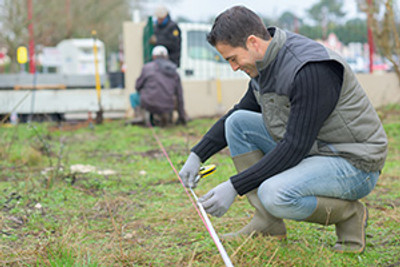How to Measure and Plan for a Yard Fence
Installing a fence in your yard can enhance its privacy, security, and aesthetic appeal. Whether you're planning to create a safe space for your children or pets, define property boundaries, or simply add charm to your outdoor living area, careful measurement and planning are essential for a successful fence project. In this blog post, we'll guide you through the steps to accurately measure and plan for a yard fence.
Step 1: Check Local Regulations
Before you start planning your fence, it's crucial to check with your local authorities and homeowner's association (if applicable) to understand any zoning regulations, height restrictions, and permit requirements. Failing to do so could result in costly delays and potential legal issues.
Step 2: Identify Your Goals
Determine the primary purpose of your fence. Is it for privacy, security, aesthetics, or a combination of these? Knowing your goals will help you choose the right fence type and materials.
Step 3: Select Fence Type and Materials
Now that you have a clear purpose for your fence, you can choose the appropriate fence type and materials. Common fence types include:
- Wooden Fences: Classic and versatile, wooden fences come in various styles like picket, privacy, and ranch. They can be made from cedar, pine, or redwood.
- Vinyl Fences: Low-maintenance and durable, vinyl fences mimic the look of wood without the need for regular painting or staining.
- Chain-Link Fences: Affordable and functional, chain-link fences are often used for security and pet containment.
- Wrought Iron Fences: Elegant and decorative, wrought iron fences add a touch of sophistication to your property.
- Aluminum Fences: Lightweight and durable, aluminum fences are resistant to rust and require minimal maintenance.
- Composite Fences: A combination of wood and plastic, composite fences offer the appearance of wood with the durability of plastic.
Step 4: Measure Your Yard
Accurate measurements are crucial to ensuring that you purchase the right amount of materials and that your fence fits perfectly within your property. Here's how to measure your yard:
- Use a measuring tape to measure the perimeter of your yard. Start at a fixed point, like your house or an existing fence, and work your way around the property.
- Note any irregularities, such as slopes or changes in terrain, as these will affect your fence installation.
- Measure the width of any gates you plan to install, as well as the distance between fence posts.
Step 5: Plan for Gate Placement
Gates are essential for accessing your yard, so carefully plan where you want them. Consider the following:
- Primary access points: Determine the main entrance and exit points in your yard.
- Gate size: Measure the width of any vehicles or equipment that need to pass through the gates, ensuring they are wide enough.
- Gate style: Choose gate styles that match your fence and provide the level of security and privacy you desire.
Step 6: Calculate Materials
Based on your measurements, calculate the materials you'll need, including:
- Fence panels or pickets
- Posts
- Rails
- Gate(s)
- Fasteners (nails, screws, etc.)
- Concrete (for securing fence posts)
Step 7: Budget for Your Project
Once you have your materials list, research prices and create a budget for your fence project. Be sure to account for any additional costs, such as labor if you plan to hire a professional installer.
Conclusion:
Planning and measuring for a yard fence may seem like a meticulous process, but it's essential for a successful and aesthetically pleasing installation. By following these steps and considering your specific needs and preferences, you'll be well-prepared to embark on your fencing project and create a beautiful and functional addition to your outdoor space. Remember to always prioritize safety and compliance with local regulations throughout the process.
Recent Posts
-
Plumb vs. Level: Understanding the Difference in Fence Post Installation
When it comes to installing a fence, getting the job done right the first time is crucial. One of th …Jun 19th 2025 -
Navigating Hills with Aluminum Fencing: A Smooth Journey
Aluminum fencing is a popular choice for property owners looking to secure their homes and beautify …Jun 4th 2025 -
Choosing the Right Height for Your Fence: A Practical Guide
When it comes to selecting the perfect fence for your property, one of the critical factors to consi …May 14th 2025








